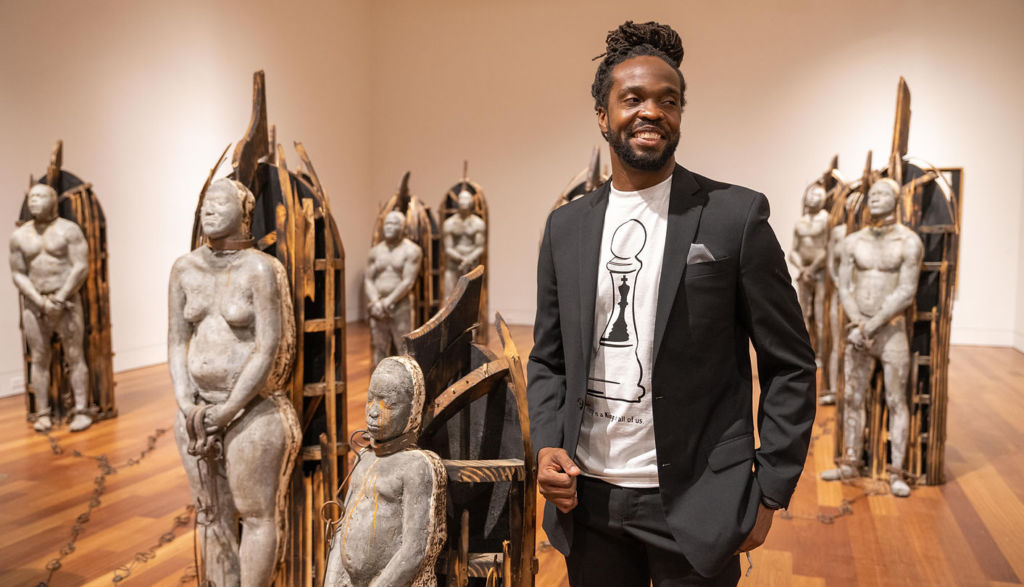Artist Stephen Hayes Elevates the Humble Dandelion in 'Wishes of Historic West End'

By Page Leggett
Chances are, you haven’t thought much about dandelions lately. That is, unless they’ve popped up on your otherwise manicured lawn.
It’s a good thing Durham-based artist Stephen L. Hayes, Jr. has given plenty of thought to them, though. In December, he completed “Wishes of Historic West End” – a public artwork for Stewart Creek Greenway that pays homage to the West End’s historically Black communities –using 13-feet-high metal dandelion sculptures as visual metaphors for resilience.
The work’s design takes inspiration from the last stage of the dandelion when the yellow flower head has matured into a fluffy spherical seed head. It’s the stage at which you can blow on the fluff, make a wish and send little fluffs sailing on the wind.
“In walking the site, I was thinking about being a kid and finding, blowing on and making a wish on a dandelion,” Hayes said. “People think it’s a weed – something to be gotten rid of. Dandelions get uprooted. I thought of the wishes people who once lived there had.”
It’s an apt symbol for the people of the Black communities that thrived in the area: Seversville, Lakewood and Historic West End.
Even though some West End neighbors have been displaced as the neighborhood undergoes gentrification, “Wishes of Historic West End” is a hopeful work.
“The people who once lived, and still live, here can make new wishes,” Hayes said.
Weeds have survival skills. They’re tenacious. The strongest humans are that way, too.
Hayes’ process in creating the site-specific artwork was both methodical and organic. It involved, he said, “visiting the site, being inspired by nature, learning about its history and listening to stories.”
He devised the process himself; no one at ASC gave him a template.
“Our ASC contracts require the artist to engage with community,” said ASC Project Manager for Public Art Randella Foster. “We’re never prescriptive on how that happens. Stephen really inspired engagement and made the process – the journey – meaningful for all the folks involved. He made sure that this artwork is reflective of the community involved; it has really transformed that space.”
Public art, public input

ASC and Mecklenburg County Park and Recreation held two community forums – virtually, due to the ongoing pandemic – to seek community input. In stakeholder sessions, Hayes heard a sense of pride from residents and former residents – but a sense of wistfulness, too.
He used their actual words as inscriptions on the larger-than-life metal dandelions he built from aluminum and steel:
- Seed 1: Make history now, economic integration, equity, growth, authentic
- Seed 2: Reunion, love, history, reflection, remembrance
- Seed 3: Diverse community, children, belief, preserving culture, strong families
- Seed 4: Truth, educate, consciousness, engage, together
- Seed 5: Community, engagement, equality, empower, perseverance
- Seed 6: 09.04.1957, Gus Roberts, Dorothy Counts, Delois Huntley, Girvaud Roberts
The sixth dandelion sculpture pays tribute to people from these westside neighborhoods who integrated Charlotte-Mecklenburg Schools on Sept. 4, 1957.
He did something beyond constructing a visual metaphor of strength and grit. He constructed park benches near his dandelion sculptures to encourage conversations and story sharing. In a community being dismantled bit by bit, he’s helping to rebuild that sense of community.
“One of our goals was to create this seating area where you can have some dialogue about the past and the future,” said Brian Bennett, a planner for Mecklenburg County Park and Recreation. “It’s very impactful. It’s captured the feedback from the community – all these hopes and dreams and aspirations and the things that people love.”
Said Katie Lloyd, also a planner with Mecklenburg County Park and Recreation, “I think, because of the site and how Stephen placed [the dandelion sculptures] along the Greenway, viewers are moving through that space, which causes you to see them through the lens of movement. I think that definitely helps tell that story of them spreading and flying.”
The work is primarily designed to be enjoyed by those walking and cycling the Greenway, but you can see it from a vehicle when you’re driving on State Street. It forms sort of a gateway to the neighborhood, Bennett said.
An artist is born

Hayes grew up in Durham with his older brother, Spence, and his mother, Lender, who were integral in shaping his creative approach. When Hayes was in first grade, he broke a remote-control car. Spence took it apart and attached the motor to a battery, bringing it back to life.
Amazed, Hayes began breaking all kinds of things to see how they worked and what he could create with the remnants. He’s been an artist since childhood. He earned an MFA in sculpture from the Savannah College of Art and Design (SCAD) in Atlanta. He started teaching at the college level in 2011 and is an associate professor of sculpture at Duke University.
A sense of place and purpose

There’s no plaque or marker up – yet – that explains what these massive dandelions and park benches are. That will happen soon. But both ASC and Mecklenburg County got calls from people who were excited by what they saw and wondering just what it was.
“Stephen is very talented, very in tune with talking with community,” Foster added. “And I think that was really important with this particular project on engaging those three neighborhoods. I think people were excited to be able to work with an African-American artist.”
“Their concern was that gentrification is occurring,” Foster said. “They wanted to make sure that their history and their community aren’t forgotten.
“The aesthetics of it are beautiful. But there’s a much deeper meaning beyond that. This work shows how the people of this community want their history reflected. This work shares the hopes and dreams of people who call this community home. The sculptures convey meaning to people who may not live there but are traveling through the area.”
Like people and plants – and everything else – the sculptures will change over time. Their surface will develop a patina showing their age and resilience. It’s exactly as the artist intended. Said Hayes: “It 100% matches my vision.”
It’s a vision he had from even before he submitted his idea to ASC – a memory from childhood.
“Most people consider the dandelion to be a weed and want to remove it from their yard,” wrote Hayes in his artist statement for the public artwork. “As a child we would pull them up at the last stage and blow them. The blowballs then become a wish. The intent of the artwork is to show who and what has come from this community and their impact, to inspire people to look into the history of the communities and also bring a form of play and make an impact.”

